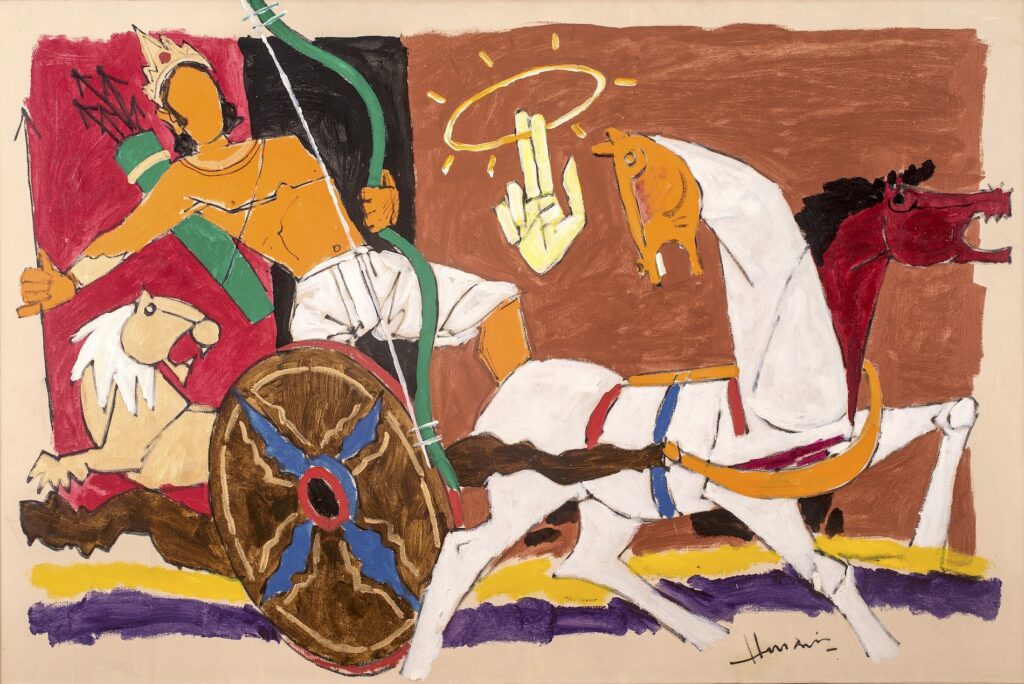ARTIANA’s upcoming online auction of Classical, Modern and Contemporary South Asian Art on December 6-10, 2018 highlights this distinct work of Maqbool Fida Husain. This new-to-market work based on the Mahabharata is the most valuable lot in the upcoming sale, both in terms of price and history behind the artwork.

 Maqbool Fida Husain – ‘Arjun and Sudarshan Chakra’ – circa 1980s – Acrylic on canvas – 40 x 60 in. (102 x 153 cm.) – Lot 21
Maqbool Fida Husain – ‘Arjun and Sudarshan Chakra’ – circa 1980s – Acrylic on canvas – 40 x 60 in. (102 x 153 cm.) – Lot 21For decades, MF Husain had been a leading, almost magical figure in the Indian art scene. Known as the “Picasso of India”, his works have defined modern Indian painting and helped in creating a niche for Indian art, not only in the society of art but also in the prestigious art markets of the world. Enormously prolific, Husain, created works that could be caustic and funny as well as serious and somber.
Among his best-known works are based on the Mahabharata. The Hindu epic narrates the founding of ancient India culminated by the Kurukshetra War fought between Pandava and Kauravan cousins in a dynastic struggle for the throne of Hastinapura, the seat of the Kuru clan. The present work portrays Lord Krishna and the Pandava prince Arjuna before the commencement of the climactic war. Arjuna stands at the chariot holding the Gandiva (bow) and his arrows. Lord Krishna, symbolized here by the abstract hand bearing the Sudarshan Chakra, was Arjuna’s charioteer and guide. Initially hesitant to go to war against his own kin, friends, and teachers, Arjuna is persuaded otherwise by Lord Krishna. The dialogue between them formed the Bhagavad Gita, one of the most important texts of Hindu philosophy.
Accentuating the violence that forms the central core of the epic, the composition is dynamic. The strong influence of Indian folk art is indicated by the division of planes which may have been derived from the narrative style in Rajasthani miniature painting. Notably, present in the painting are all of Husain’s popular symbols; the tiger, the horses, the Sudarshan Chakra, and the mudra. His signature style and engagement with the folk elements are also evident in the sharp use of colors, simple design and broad shoulders attributed to the Basholi period. By predominantly using shades of red, black and brown, Husain conveyed the violence and frenzied energy of the war while palpable movement is conveyed through the stance of the horses and the charging tiger; enhancing the mood of the whole painting.
Husain’s treatment of the Mahabharata series is considered far more abstract in form yet has more narrative elements than the rest of his works. Most of them were done by Husain in early 1971 when India is on the brink of war with Pakistan and the Indian Emergency was on its way. Referencing the Mahabharata, before the start of the great war, Arjuna turns to Krishna for advice. Krishna advises him about the nature of life, ethics, and morality when one is faced with a war between good and evil. As with the great thinkers inspired by the epic including Husain himself, the allegory of war might signify the war constantly going on within man between the tendencies of good and evil yet it might also reflect the social and political landscape of the period. The ambiguity of Husain’s visual language allows for pluralistic readings much like the Mahabharata itself.
Husain unveiled his Mahabharata series as a thought-provoking body of work as well as a timely reminder of the horrors of war. By transforming the mythic tragedy into a powerful contemporary statement, he evolved the language of his art to reach out to people in a culturally comprehensive way. An important tribute and reinterpretation, Husain uses this particular scene to explicitly call for reflection and in a way offer rationale and clarity in the midst of confusion and divisiveness.
Auction Catalogue – South Asian Art ‘Classical, Modern and Contemporary’ – December 6-10, 2018